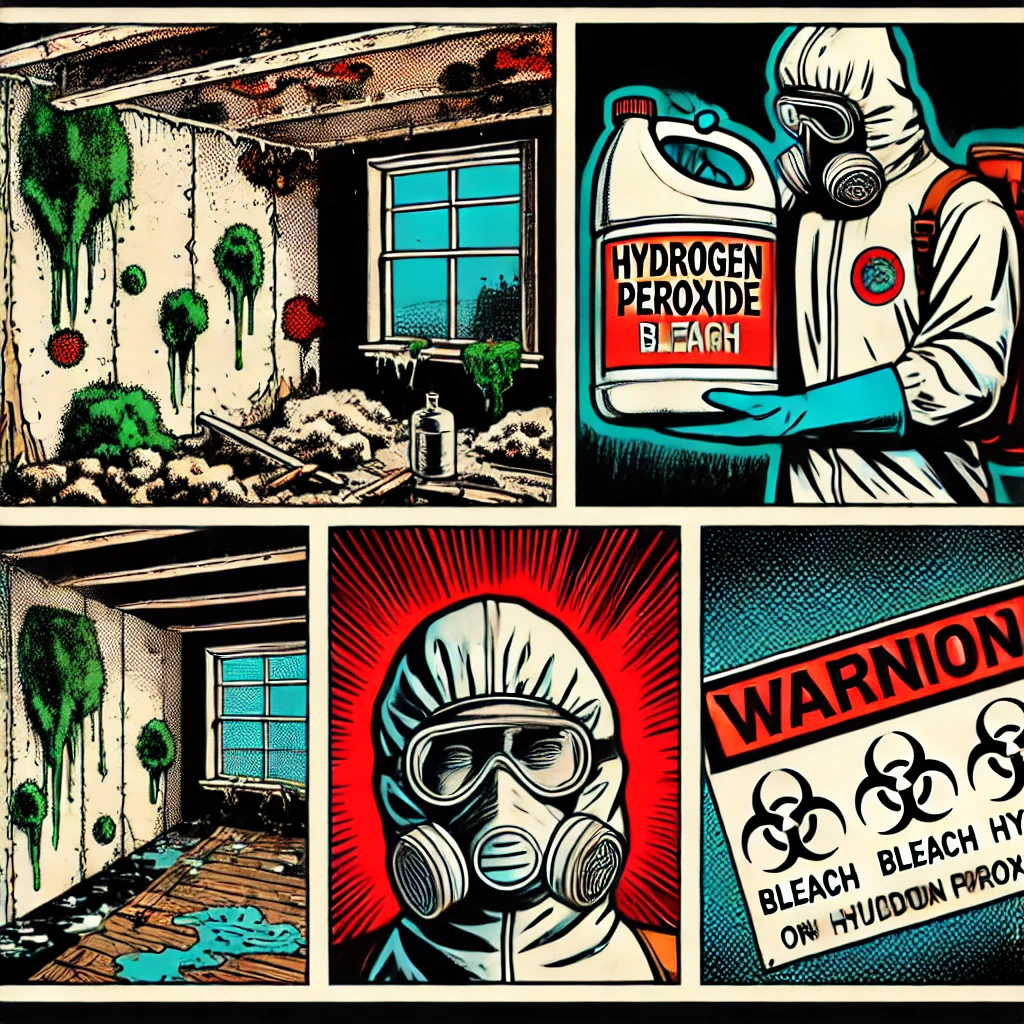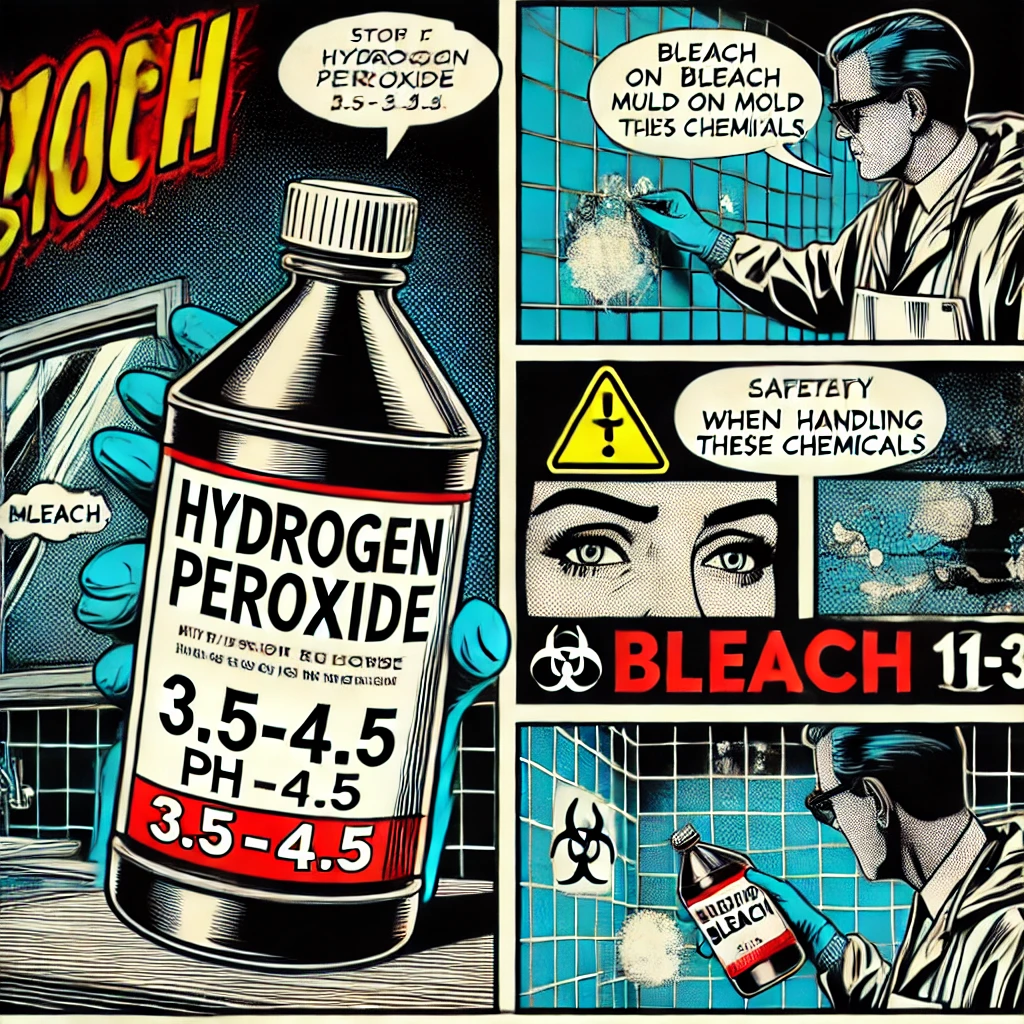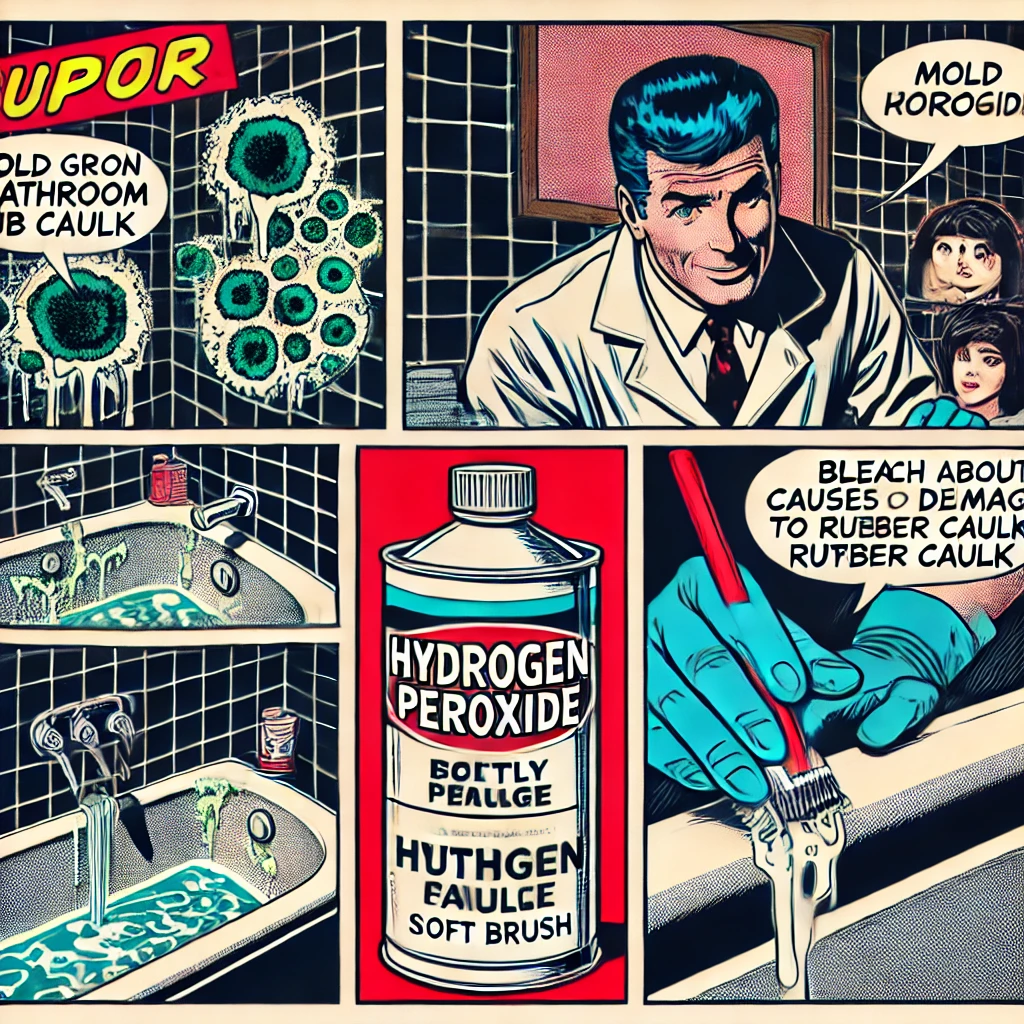Why Hydrogen Peroxide vs Bleach for Mold
This article compares hydrogen peroxide and bleach for mold removal, explaining that bleach (alkaline, pH 11-13) is perhaps “better” for surface mold on non-porous materials, while hydrogen peroxide (acidic, pH 3.5-4.5) penetrates porous surfaces effectively. It recommends bleach for tiles and glass but hydrogen peroxide for porous surfaces like drywall or wood. Both require safety precautions like ventilation and protective gear.
Why to use HP intead of Bleach, scientifically —
Thousands of youtubes, tidbits and blurbs online, many warning against using bleach on mold colonies (formed on their usual / hard-to-clean wet/damp drywall corners). Zero explained Why scientifically to my satisfaction.
Here’s Why (to use Hydrogen Peroxide instead of Bleach to kill mold on drywall) scientifically:
Both bleach and hydrogen peroxide are effective for cleaning mold, but their suitability depends on the type of surface, the extent of mold growth, and your safety concerns. Bleach (NaOCl) is alkalyne (pH 11-13) vs Hydrogen Peroxide (H2O2) which is acidic (pH 3.5-4.5). Here’s a breakdown of each:
Bleach
Pros:
- Kills Surface Mold:
- Bleach is effective at killing mold on non-porous surfaces like tiles, countertops, and glass.
- Disinfectant:
- It kills bacteria and viruses alongside mold, leaving surfaces sanitized.
Cons:
- Ineffective on Porous Materials:
- Bleach does not penetrate porous materials (e.g., wood, drywall). Mold can remain below the surface and potentially regrow.
- Harsh Chemicals:
- Bleach produces strong fumes and can irritate skin, eyes, and respiratory systems.
- Can Damage Surfaces:
- It may discolor or weaken some materials over time.
Best for:
- Non-porous surfaces like bathroom tiles, glass, and countertops.
Hydrogen Peroxide
Pros:
- Kills Mold on Porous and Non-Porous Surfaces:
- Hydrogen peroxide penetrates porous materials (e.g., wood, drywall) better than bleach, reaching deeper mold growth.
- Safer Alternative:
- It doesn’t produce toxic fumes and is less harsh than bleach on the environment and people.
- Doesn’t Leave Residues:
- Breaks down into water and oxygen, leaving no harmful byproducts.
Cons:
- May Bleach Some Materials:
- Hydrogen peroxide can cause discoloration on certain surfaces, especially fabrics or finishes.
- Slower Action:
- It may take slightly longer to work than bleach.
Best for:
- Both porous and non-porous surfaces where mold has taken root.
Recommendation
- Use bleach for surface-level mold on non-porous materials in areas like bathrooms or kitchens.
- Use hydrogen peroxide for porous surfaces or areas where mold has penetrated deeper, such as drywall, wood, or carpets.
Safety Tips:
- Always wear gloves, goggles, and a mask when cleaning mold.
- Ensure proper ventilation in the cleaning area.
- Never mix bleach with other cleaning products, especially those containing ammonia or acids, as it can create toxic gases.
If you’re dealing with extensive mold, professional remediation may be necessary.

The pH of hydrogen peroxide (H₂O₂) varies depending on its concentration, but it is typically slightly acidic, falling in the range of 3.5 to 6.5.
Breakdown:
- Household Hydrogen Peroxide (3% solution, common for cleaning and medical use):
- pH is usually around 4.5 to 5.5.
- Higher Concentrations (e.g., industrial-grade hydrogen peroxide):
- Can have a pH closer to 3.5 due to the higher presence of oxygen species.
Why It’s Acidic:
Hydrogen peroxide releases hydrogen ions (H⁺) in water, contributing to its slightly acidic nature. However, its acidity is mild compared to strong acids like hydrochloric acid.
If you’re considering hydrogen peroxide for cleaning or other purposes, its pH is low enough to act effectively but not so acidic as to cause damage in most cases.
The pH of bleach (sodium hypochlorite, NaOCl) is typically highly alkaline, ranging from 11 to 13.
Breakdown:
- Household Bleach (e.g., Clorox, 5-6% sodium hypochlorite):
- pH is around 12.5 to 13.
- Commercial or Industrial Bleach (higher concentration):
- pH can approach 13 or higher, depending on the formulation.
Why It’s Alkaline:
Bleach contains sodium hypochlorite, which in water releases hydroxide ions (OH⁻), making the solution strongly basic. The high pH also stabilizes the sodium hypochlorite, preventing it from decomposing.
Safety Reminder:
Due to its high alkalinity, bleach can irritate or damage skin, eyes, and mucous membranes. Always handle it with care and avoid mixing it with acidic substances (like vinegar), as this can release toxic chlorine gas.

Bleach vs. Hydrogen Peroxide: Which is Better for Mold Removal?
When it comes to tackling mold in your home, two common cleaning agents often come to mind: bleach and hydrogen peroxide. While both are effective under the right circumstances, each has its own strengths, weaknesses, and best use cases. Here’s a breakdown to help you decide which one is right for your situation.
How Bleach Works
Bleach, a strong alkaline solution with a pH of 11-13, is a powerful disinfectant. Its primary active ingredient, sodium hypochlorite, works by oxidizing and breaking down mold spores, effectively killing surface mold.
Pros of Bleach for Mold Removal:
- Highly Effective on Non-Porous Surfaces: Bleach is best for cleaning mold on tiles, glass, countertops, and other hard surfaces where mold cannot penetrate.
- Disinfectant Properties: It kills bacteria and viruses in addition to mold, leaving surfaces sanitized.
- Widely Available: Bleach is a common household item that’s easy to find.
Cons of Bleach:
- Ineffective on Porous Materials: On surfaces like wood and drywall, bleach cannot penetrate deep enough to kill mold roots, which can lead to regrowth.
- Harsh Chemicals: Bleach fumes can irritate the skin, eyes, and respiratory system. It can also damage certain materials or discolor them.
- Dangerous Reactions: Mixing bleach with acids (like vinegar) or ammonia releases toxic chlorine gas.
How Hydrogen Peroxide Works
Hydrogen peroxide, typically sold as a 3% solution with a pH of 3.5-4.5, is a mild antiseptic and oxidizer. When applied to mold, it releases oxygen, breaking down the mold’s structure.
Pros of Hydrogen Peroxide for Mold Removal:
- Effective on Both Porous and Non-Porous Surfaces: Unlike bleach, hydrogen peroxide can penetrate porous materials like wood and drywall to attack mold at its roots.
- Environmentally Friendly: It decomposes into water and oxygen, leaving no harmful residues behind.
- Safer to Handle: Hydrogen peroxide doesn’t produce toxic fumes and is gentler on the environment.
- Discoloration Prevention: It’s less likely to damage or bleach materials compared to sodium hypochlorite.
Cons of Hydrogen Peroxide:
- May Bleach Some Surfaces: While gentler than bleach, it can still cause discoloration on some fabrics or finishes.
- Slower Action: Hydrogen peroxide may take slightly longer to work compared to bleach.
Comparison Table: pH and Suitable Surfaces
| Cleaning Agent | pH Range | Suitable Surfaces | Notes |
|---|---|---|---|
| Bleach | 11-13 | Non-porous (tiles, glass) | Best for hard surfaces; does not penetrate porous materials. |
| Hydrogen Peroxide | 3.5-4.5 | Porous and non-porous | Effective on wood, drywall, and fabrics; environmentally friendly. |
When to Use Bleach
- Non-Porous Surfaces: Ideal for tiles, glass, bathtubs, and sinks.
- Visible Mold: Use bleach to sanitize and remove visible mold growth on hard surfaces.
- Disinfection Needed: Great for areas requiring thorough disinfection, such as kitchens and bathrooms.
When to Use Hydrogen Peroxide
- Porous Materials: Perfect for mold on wood, drywall, carpets, and other absorbent surfaces.
- Safer Cleaning Needs: For those sensitive to fumes or harsh chemicals, hydrogen peroxide is a better option.
- Eco-Friendly Cleaning: When environmental impact is a concern, hydrogen peroxide is the greener choice.
Safety Tips for Mold Removal
- Protect Yourself: Always wear gloves, goggles, and a mask to avoid exposure to mold spores and cleaning agents.
- Ensure Ventilation: Work in a well-ventilated area to minimize inhalation of fumes.
- Don’t Mix Chemicals: Never mix bleach and hydrogen peroxide (or any other cleaning agents), as dangerous chemical reactions can occur.
- Test First: Before applying either solution, test a small area to ensure no damage or discoloration occurs.
Conclusion
Both bleach and hydrogen peroxide have their place in mold removal, but their effectiveness depends on the surface and context. Use bleach for non-porous surfaces where quick disinfection is needed. Opt for hydrogen peroxide when dealing with porous materials or when you want a safer, more eco-friendly approach. Whichever you choose, always prioritize safety and address mold issues promptly to prevent further damage and health risks.

And, here’s why to use Hydrogen Peroxide instead of Bleach on bathroom tub tiles (that use butyl rubber caulking) —
When cleaning mold on butyl rubber caulk around a bathroom tub, hydrogen peroxide is generally preferable to bleach, as it is less likely to cause damage to the material over time. Here’s why:
Hydrogen Peroxide
- Gentler on Materials: Hydrogen peroxide is less harsh than bleach and won’t degrade or discolor butyl rubber caulk as readily.
- Effective Mold Killer: It penetrates the surface slightly and kills mold at its root, which is beneficial for caulk.
- Environmentally Friendly: It breaks down into water and oxygen, leaving no harmful residues.
Bleach
- Harsher on Caulk: Bleach can cause the rubber to become brittle or deteriorate over time, especially with repeated use.
- Surface-Level Cleaning: Bleach works well on visible mold but doesn’t penetrate as effectively into the caulk, which may allow mold to return.
Recommendation
- Use 3% hydrogen peroxide for routine mold cleaning on butyl rubber caulk.
- Apply the peroxide directly to the affected area, let it sit for 10–15 minutes, then scrub gently with a soft brush and rinse thoroughly.
- Avoid prolonged or frequent use of bleach on caulk, as it can weaken the material.
If the caulk is heavily moldy or damaged, replacement might be necessary to fully address the issue. Let me know if you’d like guidance on that!